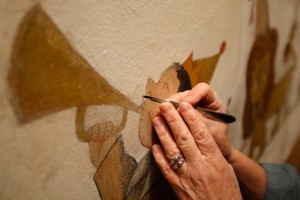In 1961, two years before he made it big with Where the Wild Things Are, Maurice Sendak painted a mural on the bedroom wall of two very, very lucky children. Larry and Nina Chertoff were six and four years old respectively when “Uncle Moo Moo” painted a joyful parade of children and animals on their wall as a favor to their parents who were close friends of his.
That’s Jennie in the front, Maurice Sendak’s dog who would later star as Max’s dog in Where the Wild Things Are. The bear is also reminiscent of illustrations Sendak did for Else Holmelund Minarik’s 1957 Little Bear series. Oh, and if you look at the umbrella in the lion’s tail you’ll see the words Larry and Nina painted in it.
When their mother, Glynn Chertoff, died a few years ago, they had to relinquish the Upper West Side apartment (it was one of those long-term rent-controlled New York situations, I gather). Larry and Nina realized they had to do something to preserve the mural or else it would just be painted over rental beige for the next tenants and the only surviving mural by Maurice Sendak would be lost forever. So they contacted the Rosenback Museum & Library in Philadelphia, the museum chosen by Sendak himself to host a massive archive of 10,000 pieces of his art and writings, and the owners of the apartment building to see what could be done.
Most wonderfully, the property owners agreed to allow the museum to take out the entire wall. The museum was able to work out the challenging logistics so that the 4-by-13-foot mural could go from the 13th (yes!) floor of a New York apartment building to Philadelphia’s Rittenhouse Square where it would become a star of the Rosenback’s Maurice Sendak Gallery.
In New York, it took a week – and a helpful vertical crack between the girl and the lion, the result of a heating pipe inside – to cut out the wall and carry it out of 241 Central Park West. The doormen cheered as the two sections, weighing 1,400 pounds, departed.
For the next three years, the mural sat face up on a special table built in the converted horse stables of Milner & Carr Conservation on Cadwallader Street in North Philadelphia, awaiting funding, nerve, and expertise. (The cost of the restoration project, including both moves, will total $200,000.) Treated to relax the paint’s brittleness, it was covered with muslin, the figures silhouetted.
It was briefly turned facedown, in order to smooth over the back (the living-room side). Finally, its weight having been shaved to about half a ton, it was loaded Jan. 19 into a white box truck and secured. The truck, with its whimsical band of marching characters on board, took its own charming, if nerve-racking, ride through the city, ending on tiny, snow-covered Panama Street behind the Rosenbach (where, of course, a garbage truck immediately tried to get down the same alley).
Once inside, the mural was wheeled and raised by pulleys, ropes, chains, and men, and finally lifted onto a specially built half-wall. Alas, when it settled onto its new base, a small horizontal fissure about a third of the way down one side opened. But all in all, there was relief.
 There is beige paint overlapping the edges of the characters, courtesy of some house painters who, just like the adults in Max’s life, wouldn’t listen to Larry when he told them not to paint between the figures. There are some cracks and some paint flaking, and of course the two pieces need to be united. Conservator Cassie Myers is restoring the mural. On Wednesdays for an hour at noon and 6:00 PM, the public will be allowed to view the restoration in progress.
There is beige paint overlapping the edges of the characters, courtesy of some house painters who, just like the adults in Max’s life, wouldn’t listen to Larry when he told them not to paint between the figures. There are some cracks and some paint flaking, and of course the two pieces need to be united. Conservator Cassie Myers is restoring the mural. On Wednesdays for an hour at noon and 6:00 PM, the public will be allowed to view the restoration in progress.
The restoration is scheduled to be completed in March. There will be a grand unveiling which Mr. Sendak is planning to attend, and then the mural will be on permanent display complete with multimedia touch screens and video of the wild rumpus that brought the parade from New York to Philly.
